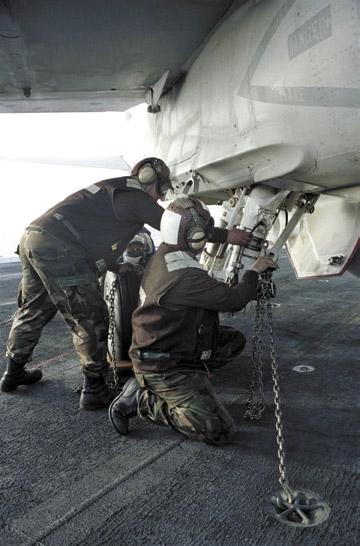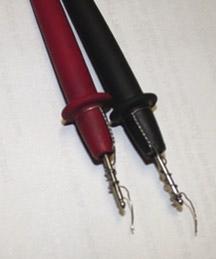
11 minute read
Letters to the Editor
You’re Not Supposed to Be Part of a Circuit!
Mech/Crossfeed, Summer 2004
Advertisement
We have ordered the multi-meter leads discussed in the Good, Bad and Ugly and Crossfeed section. After one week’s use, they are starting to show signs of wear. The plastic case is stiff and not flexible, and the tips are easily bent. They don’t hold up too well. I’m going to visit the local manufacturer to tell them about my concerns. So far, the troops aren’t using the safety wire any more, but I can tell they don’t like these new test probes, either. Thanks again. The articles are now on the safety board. —Warrant Officer Mark Riddle, ACE HMH-466
I hope you have good luck with your visit to the vendor. If they have a better product, please let Mech know. The danger of using safety wire on the lead ends of the multi-meter isn’t worth the risk of shock or electrocution. Using the right tool for the job is best, even if the tool’s quality isn’t the best.—Ed.
A Simple Ride in the Desert
Mech, Spring 2006
I just read AT2 Dobbs’ story, and, like several other experienced riders sitting here with me in the Ready Room, I’m dumbfounded that this letter made it into your usually great magazine.
Having put 25,000 miles on my 2001 Aprilia Falco, I’m quite familiar with the level of power a modern sport bike has. Hitting an animal is unlikely to have caused the situation mentioned. It’s more likely that this petty officer had been practicing wheelies or “stunting,” lost control, and crashed, damaging his friend’s bike. —East Coast E-2 Squadron
We didn’t want to question the validity of his claim; rather, we wanted to tell the readers about the good decision Petty Officer Dobbs made to wear the right clothing and PPE. The Shoie helmet and riding clothes kept him from more serious injuries. Mech’s comment about the size of the rabbit let the readers know that we weren’t sure of the actual events. Those details are best left for Petty Officer Dobbs and his friend. It’s important to note that AT2 Dobbs has appeared in the BZ section on several occasions.—Ed.
Old Maintainer
I have submitted an article for an upcoming issue of Mech magazine about the earliest maintainer on record, Mr. Charles Taylor. I hope you enjoy reading it and will find some way to use it. Thank you very much for this opportunity, and let’s keep ‘em flying! —AD2 Gary McGraw, USNR/VR-56
Charles Taylor was the mechanic who worked with Orville and Wilbur Wright, and was one of the unsung heroes of early aviation. May 24th is his birthday, and the Professional Aviation Maintenance Association (PAMA) had sought for years to make it the National Aviation Maintenance Technician Day. Mr. Taylor got long overdue recognition during the 108th Congress in 2004 when House Resolution 568 was passed, and May 24th is set aside to honor Mr. Taylor for his contributions to aviation, maintenance and engineering design, and service to his country. For more information, see Petty Officer McGraw’s story about Mr. Taylor and the links that bring the history of his life into view on our website at www.safetycenter.navy.mil/media/gallery/nostalgia/ default.htm.—Ed.

By Anonymous VFA-94 Maintainer

We recently had returned home from an extended eight-month combat deployment to the Arabian Gulf in support of Operation Iraqi Freedom. With the dangers of life at sea behind us, the squadron was rewarded with a generous stand-down period, so we could reunite and spend time with our families. Everyone was tremendously proud of a job well done and a mission accomplished successfully. It would dull quickly.
Now that we were on our home turf with no imminent threat of danger on our radars, we could afford to loosen up a bit on the maintenance push. We just had finished a combat cruise, flown thousands of hours, and dropped lots of bombs. We were at the top of our game, so we had no reason to be concerned. Right?
We started two-shift maintenance and began to get back into the routine of operating at our home base in California’s San Joaquin Valley. The priorities handed out during the morning maintenance meetings made sure enough aircraft were available for the flight schedule, no matter what it took or how full the plate. “Just give me another helping of tasks,” I thought, “and I will find a way to get it done, all with good intentions.”
The squadron was preparing for the upcoming material-condition inspection and maintenance program assist (MCI/MPA) inspection. With a team at the top of their game, this inspection should be a breeze. At least, that’s what I thought.
I worked my programs, ran the work center, knocked out all the evaluations, found time to train all these
After-cruise fl ight and maintenance schedules usually are relaxed.
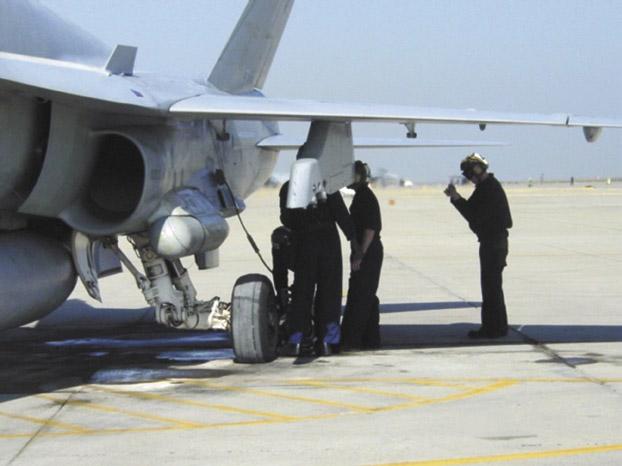
A connecting link failure on landing was the fi rst sign of trouble.

green wrench turners, and was ready to do CDI inspections on multiple jobs—oh yeah, and gave regular updates to maintenance control. If there was another priority, I’d get it done. I wouldn’t disappoint maintenance control or my division.
During this time, we got word about a possible prepare-to-deploy order (PTDO), meaning we had to be ready to go in 96 hours should it be issued. We had to cover a couple of legacy Hornet squadrons transitioning to Super Hornets—just another thing to add to the list.
As the PTDO squadron, our level of readiness needed to be at the same level as the other squadrons in the CAG. Our flight schedule increased dramatically, as did our workload. Of course, the more we fly…the more they break. This is a cause and effect that we all accept, and it is the price of doing business in naval aviation.
The workload kept growing, and I found myself drowning ever so slowly, trying to get these aircraft up and knock out everything else. Before I knew it, my days started getting longer and longer, and I tried to keep up.
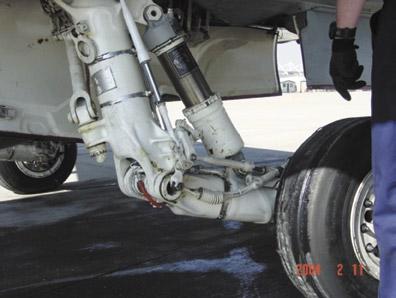
Yes, my plate was full, but I thought I could handle it. I didn’t want to let down the chiefs. QA was in my shop daily to see how we were coming along for the inspection. I didn’t want to admit it, but we all were getting further and further behind. I was up late at home working on evaluations and other admin stuff that I couldn’t get done during the day. I had good intentions of getting it all done, no matter how much time it took. Then things started going from bad to worse. We had completed a phase inspection on one of our jets, and, during the post phase flight, the aircraft had had a connecting-link failure on landing. The pilot declared an emergency and circled the airfield. He eventually made a field arrestment at the end of the runway. The pilot was OK, and we could fix the aircraft without much difficulty.
My crew gathered the necessary tools and parts and went to work replacing the bent connecting link. I had the publication on the job, but, since I had done this procedure many times before, I was certain the book

Replacing a bent link is a relatively easy job to do, when the MIMs are followed.
Checking the rigging of the landing gear is a critical step, also addressed in the MIMs.
wouldn’t tell me anything I already didn’t know. During this job, a few work center questions arose, distracting me from the task at hand. I broke away from the job to answer the questions in the shop. In my absence, nobody read the pub—primarily because I was a poor example and did not read it myself.
We also had another aircraft in phase, and the crew on that jet had some questions regarding the work they were doing. So, I climbed on top of the aircraft to address their questions. Maintenance control was calling me to go out to the flight line and troubleshoot a hydraulic leak on an aircraft trying to launch. While troubleshooting that aircraft, we discovered the problem was more than a loose line; it was another failed component. At this point in the day, it was almost time for shift change, and I remembered maintenance wanted the aircraft with the connecting link off jacks before night check arrived for work.
I went back to the hangar exhausted and didn’t recognize the indicators of being overwhelmed and overtired. I told maintenance control the flight-line aircraft was down because of an excessive leak from the hydraulic drive unit. After a while, I was able to get back to the aircraft on jacks, and I noticed that night check was arriving. The crew had the connecting link replaced and ready for operational checks. I knew one of the maintainers had done this job before, and I rushed right into the operational check without checking and verifying the rigging of the landing gear. The aircraft dropchecked fine for the CDI and QA, so it was lowered to the deck.
The next day, that same aircraft with the bad connecting link had another issue with landing gear while landing. This time, our maintenance officer was flying the jet. Maintenance control told me about the situation and asked if I could offer any advice to help the pilot. After troubleshooting and declaring an emergency, he made a field arrestment at the end of the runway.
Both of these landing-gear incidents easily could have ended in a major mishap. After the aircraft was towed back to our flight line, I went out to inspect the damage. The planning link was bent severely because of an incorrectly rigged connecting link. I went over the steps in my head, trying to figure out how this problem could have happened. While going back over the steps of the maintenance evolution and how we did the work, I was sick because I had not used the publication on this job. I just was trying to get the jet up. My intentions had been good, but my maintenance practices and leadership was poor. Maintenance malpractice was a term at the forefront of my mind. Yes, I felt overwhelmed and tired, but I had lost sight of good judgment. We cannot be combat ready if we don’t get it right the first time.
No one was hurt, and the aircraft wasn’t damaged severely, but it could have been different. I have learned that luck has no place in the maintenance business. Doing by-the-book maintenance is the only way to minimize risk.
I also learned a valuable lesson about identifying the signs of task saturation and using other resources, like CDIs from other work centers who are qualified to inspect your work. QA also could and should be used. It is important to talk with your division chief and the maintenance chief about resolving or resetting priorities. Good leaders know when to cry “uncle,” and good intentions are no excuse for poor results.
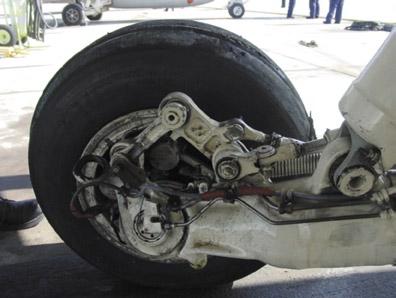
By AOAN George Frede and AMAN Joshua Harper

The flight deck is a place where decisions are made at a moment’s notice, and maintainers make many of them in a day. You can’t afford to make bad ones. You learn the things you should do and many things you shouldn’t, but it is important to remember to put safety first. We didn’t and learned a lesson the hard way.
We were running around the deck, trying to do our job as fast as possible. As soon as our aircraft came in for a hot-pump and hotseat evolution, we moved in quickly to put on chains.
We went under the nose of the aircraft, which was parked inboard of the island and right next to the foul line. That safety item is a red-and-white line painted on the deck to provide safe clearance for personnel during recoveries. We were working to get the aircraft chained down so fueling and crew shift could take place. In doing so, we stepped over the foul line and put ourselves in unnecessary danger.
We got our priorities wrong and were working for speed, quality, and safety, rather than for safety and quality first and speed last. The flight deck is a dangerous place, and it’s critical always to be aware of your surroundings. It isn’t enough just to look out for yourself; you should have your head on a swivel and watch those around you, too. We are all a part of a bigger team, and each of us needs to look out for our fellow shipmates. We knew the general rule of staying three feet away from the foul line to avoid crossing it.
We now know that taking a few extra seconds to put on chains would have kept us well behind the foul line, and we still would have accomplished our task in plenty of time. More importantly, it would have upheld the squadron’s motto: Safety, quality, and speed.
Airmen Frede and Harper work in the line division at VFA-146.
Navy photo by PH2 Robert McRill Plane captains tie down an FA-18 Hornet.
